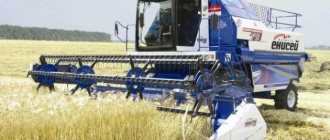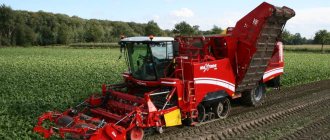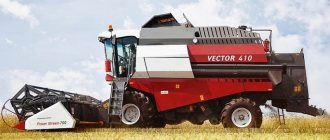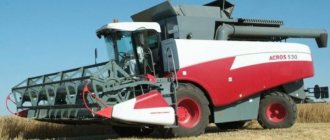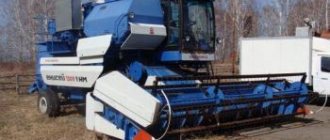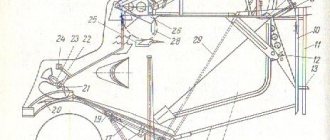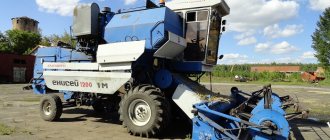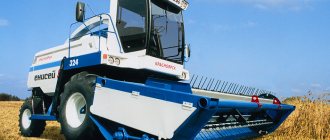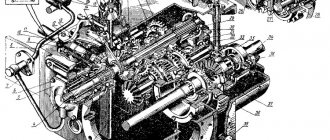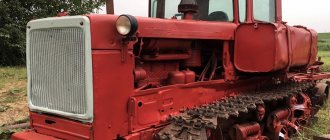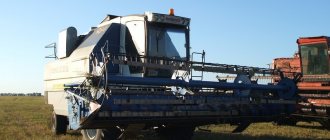Combine Harvester Maintenance
During harvesting work, equipment should definitely be checked, especially paying attention to those components and assemblies that will bear more load.
At the height of the harvest, the main factor that influences the optimal performance of grain harvesting is the proper preparation of grain harvesting equipment. Combines and headers must be tuned from segment to compaction.
The readiness of the combine determines how it will work in the harvest: up to 80% of downtime in the field is associated with poor preparation of the machines. First of all, pay attention to the adjustment of the basic installation adjustments. This should be the regulation of the grain heap cleaning system, the threshing drum and concave, and the protective clutch. All this will directly affect the further operation of the equipment.
Pay attention to the safety clutch of the header transmission shaft. It should be set to 50 kg/m. If a very large part of the grain-stem mass gets there, then this clutch must operate, otherwise the mass may jam it. Setting up the coupling in the field can take up to 2-3 hours.
You also need to pay attention to the upper feeder shaft. Here the recommended clutch setting is 60 kg/m. If it is set to a different mode, this may cause the combine to stop and, again, waste of precious time. If the clutch has not worked for a long time and is rusty, then it may not work not because it is tightened by springs, but simply because the disc and friction circle are stuck together.
The following settings are also an important element of preparation. The gap between the ridges of the feeder chamber and the bottom of the combine should be 5-10 mm. If the gap is larger, this may lead to overload on the chain and floating roller springs. Then malfunctions may occur. If the gap is smaller, another problem will arise: the scrapers can scrape along the bottom of the feeder and make a hole in it. The gap between the auger spirals and the bottom of the header should be 6-16 mm.
The drums must have adjustment controls. If you tighten the deck, the threshing gap at the inlet should be 14 mm, and at the outlet - 2 mm. Each crop must have its own adjustment of the gaps at the inlet and outlet, as well as on the upper and lower sieves. When the cleaning begins, then all these measurements must be adjusted depending on many factors. When the grain is dry, the gaps should be increased, etc.
Pay special attention to the seal. If the combine is new, all existing seals must be carefully tightened and properly prepared. In particular, pay attention to the gaps between the feeder and the header. They should not exceed 1-1.5 mm. On the thresher, casing, and grain hatch, also check what is sealed and how. Then in the field you won’t realize that grain is being lost somewhere.
A separate conversation about the cutting knives of the reaper. On classic headers, there should be no gap between the two cheeks on the rocker washer mechanism. Because the presence of a gap can cause knocking and failure of the entire header. The improved design of the header has a planetary mechanism for driving the knife, and here it is imperative to ensure that the ball bearings are lubricated. Otherwise, this also leads to failure of the cutting device. The cutting segments themselves need to be changed every 2-3 years, when the knives have worked for approximately 400-500 tons of grain.
Preparation for operation of foreign-made grain harvesters must meet the requirements for this equipment. It must be reliable, high-performance, with a modern level of comfort. The main thing is to thoroughly train your staff before starting work. Engineers and machine operators simply must know well how each component or unit in which malfunctions may occur should work. They should not be afraid and have a good command of the combine’s electronics, because without this it is impossible to work on modern equipment.
After working the first 50 operating hours harvesting grain crops, you must check all the belts on the combine. This is due to the fact that rubber products have the ability to stretch and, if they are tightened, fail.
It is also advisable to do daily maintenance of the combine. This applies to checking that all oils are present. Each combine has a lubrication card, and it clearly indicates after how long and which points need to be lubricated.
The cutting apparatus must be inspected regularly - during operation, segments may break off and fingers may become bent. If you do not pay attention, this leads to poor-quality cutting of the stem and grain loss.
When you start threshing crops, do not forget to inspect the lower part of the combine, which often scoops up soil when working on uneven fields. Therefore, make it a rule to do such an inspection and, if necessary, clean the working units from soil.
It is necessary to visually inspect the straw walker and the sieve, because sometimes foreign objects get there. On the header, make sure that the auger fingers are in working order. After all, due to the ingress of stones, they can fail. If you have a Power Flo type header, then monitor the degree of roughness of the belt. After all, if you don’t do this, it will fail in just one season. With proper use, this tape lasts 5 seasons.
If the combine is new, then do not forget to make adjustments for a specific crop before starting harvesting. This depends on the weediness of the crops, humidity, grain fraction, the contour and size of the field where the harvest will take place. That is, find out on the spot how best to set up the equipment so that it works as efficiently as possible.
Now about preparing for operation a grain harvester that has already been in operation. When buying such a used car, ask the seller about the engine parameters - if he refuses to provide information about compression, oil pressure, it may be better to abandon this model altogether. It is possible that you will then have to seriously repair the engine.
It is imperative to lubricate all components and assemblies - as they say, possible and impossible places. You also need to check the tension of all chains and fastenings of the drive sprockets.
Question about adjusting the springs of a 7 meter header
Artem Ponomarev August 24, 2022 Artem Russkikh August 24, 2022 Gennady Dmitriev August 24, 2019
Related Posts
Why might a combine occasionally burp from the feeder into the header? There was no such thing with grains, but with soybeans it was the same.
- Author: Gennady Lavrikov
- 16 September 23:30
- 1 comment
Guys, why can the combine harvester occasionally “burp” from the feeder chamber back into the header? This didn’t seem to be the case with grains, but I went out and showed soybeans... tell me where to go?
On the Yenisei 1200, the header is 6m. Why doesn’t the mown mass go on an inclination, spin around the consular and little by little pick it up?
- Author: Yuri Bobrov
- 01 September 21:00
Hi all. Please tell me about the Yenisei 1200, the header is 6m from the Soviet year of manufacture, the cut mass does not tilt, it turns around the consular and little by little it only picks up, the conveyor is new, it is positioned correctly, tensioned.
Why does the Vector 410 with a 7-meter header have trouble swallowing the mass? The reel and auger were adjusted differently, but the straw still rotates around the auger.
- Author: Denis Timanov
- 04 August 19:00
Hi all. Guys, please tell me why the Vector 410 with a 7-meter header does not “swallow” the mass well. We tried to regulate both the reel and the auger in different ways. They didn’t really achieve anything except spinning the straw around the auger and twisting it. The combine is new. By the way, all sorts of garbage accumulates in front of the conveyor.
Ksk 600 2022. Why did the feeder and the header suddenly stop turning on? The oil is forced through the pump, but goes back to the hydraulic tank.
- Author: Matvey Smirnov
- July 25 10:00
- 4 comments
Hey guys, this is the problem. Ksk 600 2022, the feeder and the header suddenly stopped turning on. We tried everything, from electrics (checking all relays, continuity, sending a direct signal) to hydraulics (removing all valves (everything is clean and does not bite), the drive coupling did not break). Somehow the header jerked a couple of times, but then nothing happened. The oil is forced through the pump, but goes back to the hydraulic tank. Help, maybe someone has encountered something similar.
Yenisei 1200 combine harvester: all technical characteristics and features of use in the garden plot
Yenisei 1200 combine harvester: all technical characteristics and features of use in the garden.
For livestock farming, the problem of feed is the most pressing; the Yenisei 1200 combine harvester will solve it, with subsequent processing of the grain itself.
General information about the Yenisei 1200 combine.
For livestock farming, the problem of feed is the most pressing; the Yenisei 1200 grain harvester will solve it by growing and harvesting feed with subsequent processing at home.
In Russia I use two cleaning technologies that have been used for several centuries.
continuous, using this technology the mown grains are immediately threshed. Previously, the hay was taken to the threshing floor, and there they were beaten with flails to separate the grain from the straw and impurities; now the cut grain is immediately threshed on a combine, the grain is accumulated in a bunker, and the straw is collected separately.
Adjusting the clutch of the Niva SK-5 combine harvester
Questions can only be asked after registration. Please login or register.
Help. Describe the process of adjusting the clutch of the NIVA SK-5 combine or share the repair and operation manual for the Niva SK-5 combine.
For the chassis transmission clutch. If disassembled, then: in assembled form, with the pulley not installed on the input shaft, install a distance of 25 mm between the working surfaces of the release levers and the driven disk hub. Install the pulley on the primary gearbox. Using the pusher of the working hydraulic cylinder, set a gap of 2.5 between the working surfaces of the release levers and the release bearing. 3.5 mm.
Hello !! There is a wiring diagram for the dispenser pump.
Tell me the procedure for adjusting the valves on the Niva SK-5 and the clearances in the valves.
Tell me the procedure for adjusting the valves on the Niva SK-5 and the clearances in the valves.
Adjustment according to TDC 1342 is the same as everywhere else, and the gap on the hacksaw blade for metal,
0.5mm
My channel - https://www.youtube.com/user/pppatriot You are welcome to join the viber group “Farmers of Ukraine”, write in private.
Hello !! There is a wiring diagram for the dispenser pump.
Can you post the diagram on the forum?
guys drive the clutch on the combine, what should I tighten?
About the topic. Tested in practice on 2 Niva combines without a chopper, we remove half of the on-off springs on the machine’s drive clutch; the release life is much easier; no more slippage was noticed on wheat, corn, or sunflowers.
You need to tighten the adjusting bolt on the release lever//////at the top of the gearbox on the outside of the combine//// clutch or move the paws - on the inside of the clutch there are three adjusting nuts that seem to be 22, you need to tighten them each by the same amount the same angle is about half a turn, in short, by experiment - or by scientific poking.
Agrotechnical requirements
For mechanized harvesting of agricultural crops using the Yenisei 1200 combine harvester, a number of requirements presented in the table must be met.
| Controlled indicators | Dimension | Numerical value |
| Plant density for separate harvesting | pcs/sq.m | 250…300 |
| Average plant height | cm | 60…80 |
| Cutting height | cm | 12…25 |
| Roll parameters: | ||
| roll weight per 1 m length | kg | 1,2…1,7 |
| swath width | m | 1,2…1,6 |
| Grain losses during mowing: | ||
| upright breads, less | % | 0,5 |
| loaves of bread, less | % | 1,5 |
| Grain losses after the pick-up, no more | % | 0,5 |
| Amount of grain in straw due to under-grinding, no more | % | 1,5 |
| Number of hulled and crushed seeds, no more | % | 2,0 |
| Weed impurities in the bunker, less | % | 3,0 |
The requirements for the process are quite stringent. You can withstand them by adjusting all the units of the combine and making adjustments that correspond to real harvesting conditions.
